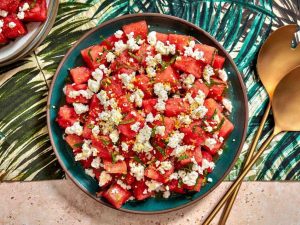Get ready to bring the vibrant flavors of Spain right into your kitchen! Whether you’re craving quick tapas for entertaining or comforting paella for family dinners, these authentic recipes will transport your taste buds to sunny Spanish plazas. From classic favorites to regional specialties, you’ll discover dishes that are surprisingly simple to recreate at home. Let’s dive into these 21 delicious Spanish recipes that will make every meal a fiesta!
Patatas Bravas with Spicy Tomato Sauce
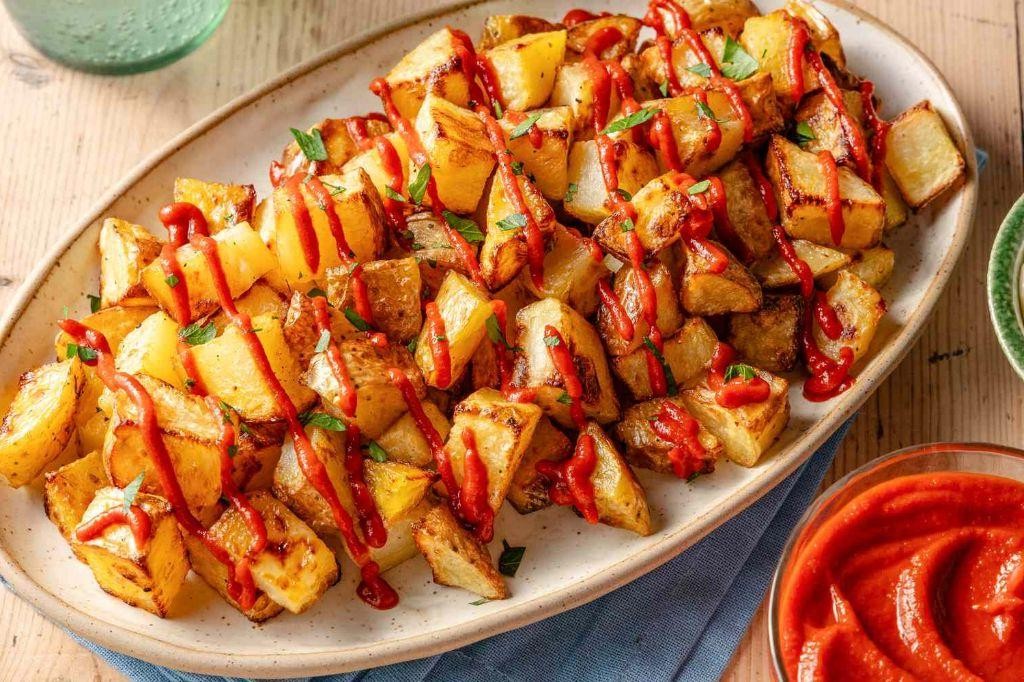
Knowing how to transform humble potatoes into a showstopping Spanish tapas dish will elevate your entertaining game instantly. Patatas Bravas delivers crispy potato cubes smothered in a vibrant, spicy tomato sauce that balances heat with rich umami notes.
Ingredients
- 2 pounds Yukon Gold potatoes, peeled and cut into 1-inch cubes
- 1/4 cup extra virgin olive oil
- 1 teaspoon fine sea salt
- 2 tablespoons Spanish smoked paprika
- 1/2 teaspoon cayenne pepper
- 1 medium yellow onion, finely diced
- 3 garlic cloves, minced
- 1 (28-ounce) can San Marzano tomatoes, crushed
- 1 tablespoon sherry vinegar
- 1/4 cup chopped fresh parsley
Instructions
- Preheat your oven to 425°F and position one rack in the upper third and another in the lower third.
- Toss the potato cubes with olive oil and sea salt until evenly coated.
- Arrange potatoes in a single layer on two parchment-lined baking sheets.
- Roast for 25 minutes, then rotate pans between racks and continue roasting until edges are golden brown and crisp, about 15-20 minutes more.
- While potatoes roast, heat 2 tablespoons olive oil in a heavy-bottomed saucepan over medium heat.
- Sauté diced onion until translucent and lightly caramelized, about 8 minutes.
- Add minced garlic and cook until fragrant, about 1 minute.
- Stir in smoked paprika and cayenne pepper, toasting the spices for 30 seconds to deepen their flavor.
- Pour in crushed tomatoes and bring to a simmer, then reduce heat to low.
- Cook sauce uncovered for 20 minutes, stirring occasionally, until thickened slightly.
- Remove sauce from heat and stir in sherry vinegar.
- Transfer roasted potatoes to a serving platter and spoon warm sauce over the top.
- Garnish with chopped fresh parsley before serving.
The contrast between the crispy potato exteriors and fluffy interiors creates perfect texture harmony. The smoky paprika and cayenne build a slow heat that complements the bright acidity of the tomatoes. For an authentic presentation, serve family-style with toothpicks for easy sharing alongside chilled Spanish vermouth.
Paella Valenciana with Rabbit and Snails
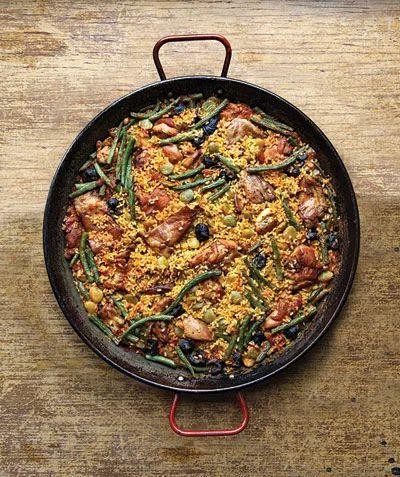
Let’s explore the authentic flavors of Valencia with this traditional paella recipe that transforms humble ingredients into a spectacular communal feast. Learning to layer flavors properly will reward you with the characteristic socarrat—that prized crispy bottom layer that defines exceptional paella. This methodical approach ensures even beginners can achieve restaurant-quality results at home.
Ingredients
- 1 whole rabbit (approximately 2.5 pounds), cut into 8 pieces
- 12 fresh land snails, thoroughly cleaned
- 2 cups Bomba rice
- 4 cups homemade chicken stock, kept at a gentle simmer
- 1 large Spanish onion, finely diced
- 4 cloves garlic, minced
- 1 large ripe tomato, grated to yield ½ cup tomato pulp
- 1 cup fresh flat-leaf parsley, finely chopped
- 1 teaspoon high-quality saffron threads
- 3 tablespoons extra virgin olive oil
- 1 teaspoon sweet smoked paprika
- 1 fresh rosemary sprig
Instructions
- Heat 3 tablespoons extra virgin olive oil in a 15-inch paella pan over medium-high heat until shimmering but not smoking.
- Season 8 pieces of rabbit generously with kosher salt and arrange them skin-side down in the hot oil.
- Sear rabbit pieces for 4 minutes per side until deeply golden brown, developing a flavorful fond on the pan bottom.
- Add 12 cleaned snails to the pan and sauté for 2 minutes until their shells become fragrant.
- Transfer rabbit and snails to a plate, leaving the rendered fat and fond in the pan.
- Add 1 finely diced Spanish onion to the hot pan and cook for 6 minutes until translucent and lightly caramelized.
- Stir in 4 minced garlic cloves and cook for 45 seconds until aromatic but not browned.
- Add ½ cup grated tomato pulp and cook for 3 minutes until the mixture darkens and thickens noticeably.
- Sprinkle 1 teaspoon sweet smoked paprika over the tomato mixture and cook for 30 seconds to bloom the spices.
- Return rabbit and snails to the pan, arranging them evenly across the surface.
- Add 2 cups Bomba rice to the pan, stirring to coat each grain thoroughly with the sofrito base.
- Pour 4 cups simmering homemade chicken stock over the rice, distributing it evenly without stirring.
- Crush 1 teaspoon saffron threads between your fingers and sprinkle evenly across the liquid surface.
- Scatter 1 cup chopped parsley over the paella and place 1 fresh rosemary sprig in the center.
- Increase heat to high and cook uncovered for 8 minutes until the liquid reduces by half.
- Reduce heat to low and continue cooking for 12 minutes without stirring to develop the socarrat.
- Remove paella from heat and let rest for 5 minutes to allow the rice to absorb remaining moisture.
This traditional preparation yields rice with distinct separate grains while developing the coveted crispy socarrat bottom. The rabbit provides rich, gamey notes that balance beautifully with the earthy snails and aromatic saffron. Try serving it family-style directly from the pan with lemon wedges for squeezing over individual portions.
Gazpacho Andaluz with Fresh Vegetables
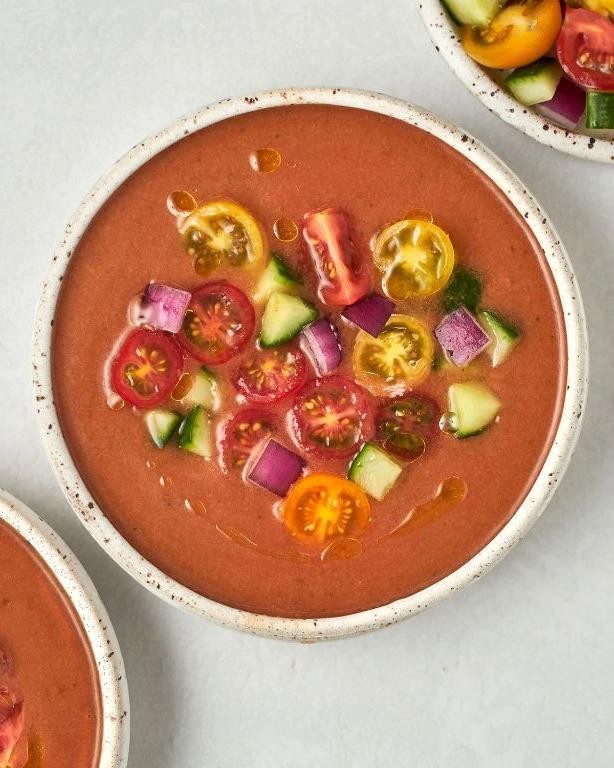
When summer temperatures soar, nothing refreshes quite like this traditional chilled Spanish soup. With vibrant vegetables at their peak, this gazpacho delivers bright, clean flavors that require no cooking at all. We’ll walk through each preparation step methodically to ensure perfect texture and balance.
Ingredients
– 2 pounds ripe heirloom tomatoes, cored and roughly chopped
– 1 English cucumber, peeled and seeded
– 1 red bell pepper, stemmed and seeded
– ½ small sweet onion, peeled
– 2 garlic cloves, peeled and smashed
– ¼ cup extra virgin olive oil
– 2 tablespoons sherry vinegar
– 1 teaspoon fine sea salt
– ½ teaspoon freshly cracked black pepper
– ¼ cup filtered water
– ¼ cup rustic bread cubes, crusts removed
Instructions
1. Combine the rustic bread cubes with filtered water in a small bowl and soak for 10 minutes until fully softened.
2. Working in two batches, place half of the heirloom tomatoes, English cucumber, red bell pepper, sweet onion, and garlic cloves in a high-speed blender.
3. Add half of the soaked bread cubes and their soaking liquid to the blender.
4. Blend on high speed for 90 seconds until completely smooth and emulsified.
5. Pour the first batch through a fine-mesh strainer into a large bowl, pressing with a spatula to extract all liquid.
6. Repeat steps 2-5 with the remaining vegetables and soaked bread.
7. Whisk the extra virgin olive oil and sherry vinegar into the strained soup until fully incorporated.
8. Season the mixture with fine sea salt and freshly cracked black pepper, whisking thoroughly to combine.
9. Cover the bowl tightly with plastic wrap and refrigerate for exactly 4 hours until thoroughly chilled.
10. Ladle the chilled gazpacho into chilled bowls just before serving.
Perfectly smooth with a velvety texture, this gazpacho showcases the pure essence of summer produce. The sherry vinegar provides bright acidity that balances the sweet tomatoes and peppers beautifully. For an elegant presentation, serve in chilled martini glasses garnished with micro-herbs and a drizzle of olive oil.
Tortilla Española with Chorizo
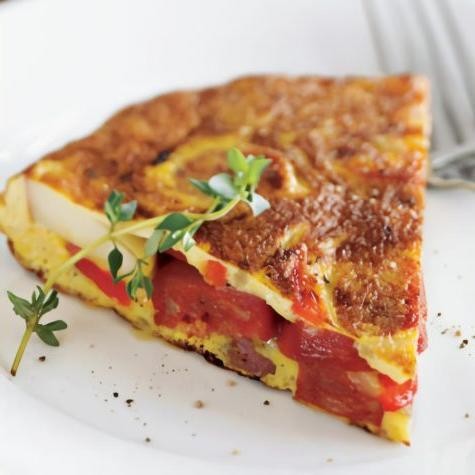
Knowing how to transform humble ingredients into a spectacular Spanish tortilla is a kitchen skill worth mastering. Keep reading as we build this classic dish with the smoky addition of Spanish chorizo, creating layers of flavor through careful technique. This methodical approach ensures perfect results every time, even for first-time tortilla makers.
Ingredients
– 1/2 cup extra-virgin olive oil
– 8 ounces Spanish chorizo, casing removed, diced into 1/4-inch cubes
– 2 large yellow onions, thinly sliced
– 3 large Yukon Gold potatoes, peeled and sliced into 1/8-inch rounds
– 6 pasture-raised eggs, lightly beaten
– 1 teaspoon fine sea salt
– 1/2 teaspoon freshly cracked black pepper
Instructions
1. Heat 1/4 cup extra-virgin olive oil in a 10-inch nonstick skillet over medium heat until shimmering, about 2 minutes.
2. Add diced Spanish chorizo and cook until fat renders and edges crisp, 4-5 minutes, stirring occasionally.
3. Using a slotted spoon, transfer chorizo to a paper towel-lined plate, reserving rendered fat in the skillet.
4. Add remaining 1/4 cup olive oil to the skillet and heat until it reaches 300°F on an instant-read thermometer.
5. Add thinly sliced onions and cook until translucent and beginning to caramelize, 8-10 minutes, stirring frequently.
6. Add potato rounds in a single layer, working in batches if necessary to avoid overcrowding.
7. Cook potatoes until tender but not browned, 12-15 minutes, turning occasionally with a spatula.
8. Tip: Maintain oil temperature between 275-300°F to gently confit the vegetables without frying.
9. Using a slotted spoon, transfer potato-onion mixture to a large mixing bowl, allowing excess oil to drain back into the skillet.
10. Reserve 2 tablespoons of the infused cooking oil for later use and discard the remainder.
11. Combine lightly beaten eggs, sea salt, and black pepper in the bowl with the potato-onion mixture.
12. Gently fold in the reserved chorizo until all ingredients are evenly distributed.
13. Heat the reserved 2 tablespoons of infused oil in the same skillet over medium-low heat.
14. Pour the egg-potato-chorizo mixture into the skillet, spreading it into an even layer.
15. Cook undisturbed until the edges are set and the bottom is golden brown, 8-10 minutes.
16. Tip: Run a rubber spatula around the edges periodically to prevent sticking and ensure clean release.
17. Place a large plate upside down over the skillet and carefully invert the tortilla onto the plate.
18. Slide the tortilla back into the skillet to cook the second side for 6-8 minutes until fully set.
19. Tip: The tortilla is done when slightly wobbly in the center but firm around the edges.
20. Transfer to a cutting board and let rest for 5 minutes before slicing.
Versatile enough for any meal, this tortilla boasts a creamy interior punctuated by crispy chorizo bits and sweet caramelized onions. Velvety egg layers embrace the tender potatoes, creating a textural symphony that shines whether served warm or at room temperature. Vibrant orange chorizo oil streaks through each slice, making this equally stunning as a tapas centerpiece or hearty breakfast.
Pisto Manchego with Poached Eggs

Keeping weeknight dinners exciting yet approachable can be a challenge, but this Spanish-inspired Pisto Manchego with Poached Eggs transforms humble vegetables into a vibrant, satisfying meal that feels both rustic and refined. Kind of like a ratatouille’s sophisticated cousin, this one-pan wonder builds layers of flavor through careful cooking techniques that even novice cooks can master.
Ingredients
– 2 tablespoons extra-virgin olive oil
– 1 medium yellow onion, finely diced
– 2 garlic cloves, minced
– 1 large red bell pepper, seeded and diced into ½-inch pieces
– 1 medium zucchini, diced into ½-inch cubes
– 1 medium eggplant, peeled and diced into ½-inch cubes
– 1 teaspoon smoked paprika
– ½ teaspoon crushed red pepper flakes
– 1 (14.5-ounce) can fire-roasted diced tomatoes
– 4 large pasture-raised eggs
– 1 tablespoon white vinegar
– 2 tablespoons fresh flat-leaf parsley, chopped
– Flaky sea salt for finishing
Instructions
1. Heat olive oil in a large skillet over medium heat until shimmering, about 2 minutes.
2. Add diced onion and cook until translucent, stirring occasionally, for 5-7 minutes.
3. Stir in minced garlic and cook until fragrant, about 45 seconds.
4. Add diced bell pepper and cook until slightly softened, about 4 minutes.
5. Incorporate zucchini and eggplant, cooking until vegetables begin to release moisture, about 6 minutes.
6. Sprinkle smoked paprika and red pepper flakes over vegetables, stirring to coat evenly.
7. Pour in fire-roasted tomatoes with their juices, scraping any browned bits from the pan bottom.
8. Reduce heat to low, cover, and simmer until vegetables are tender but not mushy, exactly 15 minutes.
9. While vegetables simmer, fill a medium saucepan with 3 inches of water and bring to a gentle simmer (180°F).
10. Add white vinegar to the simmering water to help egg whites coagulate quickly.
11. Crack one egg into a small ramekin, then gently slide it into the water, repeating with remaining eggs.
12. Poach eggs for 3 minutes for runny yolks, using a slotted spoon to remove them to a paper towel-lined plate.
13. Season vegetable mixture with salt and divide among four shallow bowls.
14. Top each serving with one poached egg and garnish with chopped parsley and flaky sea salt. The silky egg yolk creates a luxurious sauce that melds with the smoky, slightly spicy vegetable base, while the tender-crisp vegetables provide satisfying texture. Try serving it with crusty bread for dipping, or for a heartier meal, spoon it over creamy polenta or crispy roasted potatoes.
Ropa Vieja with Chickpeas and Peppers

Kicking off our culinary journey today, we’re exploring a vibrant twist on a Cuban classic that transforms simple ingredients into extraordinary comfort food. This methodical approach will guide you through creating deeply layered flavors with perfect texture balance, making restaurant-quality results achievable in your own kitchen.
Ingredients
- 1.5 pounds flank steak, trimmed of excess fat
- 3 tablespoons extra virgin olive oil, divided
- 1 large yellow onion, thinly sliced
- 1 red bell pepper, julienned
- 1 green bell pepper, julienned
- 4 garlic cloves, minced
- 1 teaspoon ground cumin
- 1 teaspoon dried oregano
- 1/2 teaspoon smoked paprika
- 1 (14.5-ounce) can fire-roasted diced tomatoes
- 1/2 cup dry white wine
- 1 cup beef broth
- 1 (15-ounce) can chickpeas, drained and rinsed
- 2 bay leaves
- 1/4 cup pimento-stuffed green olives, sliced
- 2 tablespoons fresh cilantro, chopped
- 1 tablespoon fresh lime juice
Instructions
- Season the flank steak generously with kosher salt and freshly ground black pepper on all surfaces.
- Heat 1 tablespoon of olive oil in a large Dutch oven over medium-high heat until shimmering.
- Sear the steak for 4-5 minutes per side until deeply browned, developing a flavorful fond on the pot bottom.
- Transfer the seared steak to a plate and reduce heat to medium.
- Add remaining olive oil to the pot and sauté onions for 5 minutes until translucent.
- Add both bell peppers and cook for 6-7 minutes until slightly softened.
- Stir in minced garlic and cook for 1 minute until fragrant.
- Sprinkle cumin, oregano, and smoked paprika over vegetables, toasting for 30 seconds to release oils.
- Deglaze with white wine, scraping all browned bits from the pot bottom with a wooden spoon.
- Add fire-roasted tomatoes, beef broth, and bay leaves, stirring to combine.
- Return the seared steak to the pot, nestling it into the liquid mixture.
- Bring to a simmer, then cover and reduce heat to low, maintaining a gentle bubble.
- Braise for 2 hours until the steak shreds easily with two forks.
- Remove the steak to a cutting board and shred against the grain into thin strands.
- Return shredded beef to the pot along with drained chickpeas and sliced olives.
- Simmer uncovered for 15 minutes to allow flavors to meld and sauce to thicken slightly.
- Remove from heat and discard bay leaves.
- Stir in fresh cilantro and lime juice just before serving.
This dish achieves a remarkable textural contrast between the silky shredded beef and firm chickpeas, all enveloped in a rich, aromatic sauce. The slow-braised flank steak develops an incredibly tender quality that practically melts in your mouth. Try serving it over saffron-infused rice with fried plantains for a complete Caribbean experience that highlights the complex sweet and savory notes.
Salmorejo Cordobés with Hard-Boiled Eggs
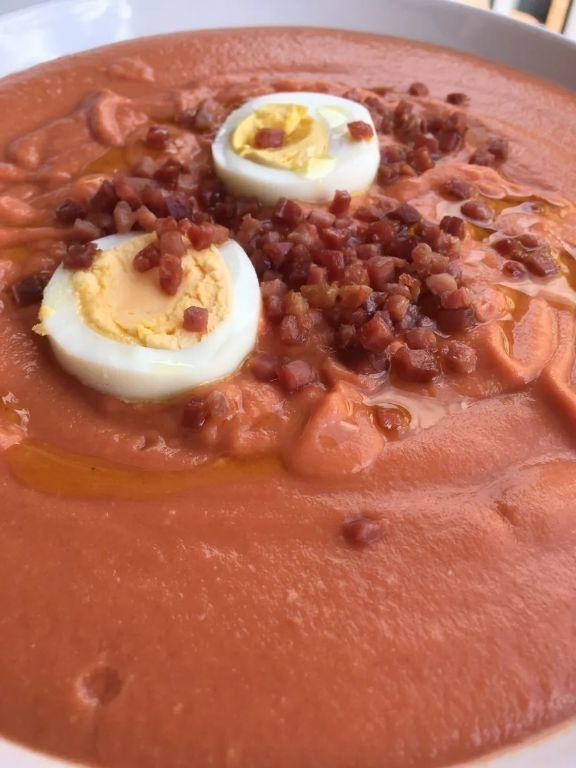
Every sweltering summer day deserves a chilled Spanish classic that requires minimal effort but delivers maximum refreshment. Salmorejo Cordobés offers a velvety, tomato-based soup that’s both nourishing and cooling, perfect for those seeking a no-cook solution to beat the heat. This version, garnished with hard-boiled eggs, transforms simple ingredients into a sophisticated, restaurant-worthy dish you can prepare ahead.
Ingredients
- 2 pounds ripe Roma tomatoes, cored and quartered
- 4 ounces day-old rustic bread, crusts removed, torn into 1-inch pieces
- 2 small garlic cloves, peeled and smashed
- ½ cup extra-virgin olive oil, plus additional for drizzling
- 2 tablespoons sherry vinegar
- 1 teaspoon fine sea salt
- 4 large pasture-raised eggs
- 2 ounces serrano ham, thinly sliced and finely chopped
Instructions
- Place the pasture-raised eggs in a medium saucepan and cover with cold water by 1 inch.
- Bring the water to a rolling boil over high heat, then immediately remove the pan from heat.
- Cover the saucepan and let the eggs stand for 12 minutes exactly.
- Transfer the eggs to an ice water bath and let cool completely for 15 minutes.
- Peel the hard-boiled eggs and chop them into ¼-inch dice.
- Combine the quartered Roma tomatoes, torn bread pieces, and smashed garlic cloves in a blender.
- Blend on high speed for 2 minutes until the mixture forms a smooth, thick purée.
- With the blender running on medium speed, slowly drizzle in the ½ cup extra-virgin olive oil in a thin, steady stream.
- Add the sherry vinegar and fine sea salt, then blend for 30 seconds until fully incorporated.
- Strain the mixture through a fine-mesh sieve into a large bowl, pressing with a spatula to extract all liquid.
- Cover the bowl with plastic wrap and refrigerate for at least 4 hours or until thoroughly chilled.
- Ladle the chilled salmorejo into four serving bowls.
- Garnish each bowl with equal portions of the diced hard-boiled eggs and finely chopped serrano ham.
- Finish with a light drizzle of extra-virgin olive oil just before serving.
The resulting texture is exceptionally smooth and creamy, with the chilled tomato base providing a tangy contrast to the rich egg and salty ham garnish. For a creative twist, serve it in chilled shot glasses as a passed appetizer, or top with crispy croutons for added texture that complements the soup’s velvety consistency.
Gambas al Ajillo with Garlic and Chili

Haven’t we all craved a dish that’s both impressively flavorful and deceptively simple to prepare? Gambas al Ajillo delivers exactly that—a Spanish tapas classic where plump shrimp sizzle in a fragrant bath of garlic and chili. Mastering this dish requires just a few quality ingredients and a methodical approach, so let’s walk through it step by step.
Ingredients
- 1 pound wild-caught large shrimp, peeled and deveined
- ½ cup extra-virgin olive oil
- 8 garlic cloves, thinly sliced
- 2 dried Guajillo chilies, deseeded and crumbled
- 1 teaspoon smoked paprika
- ¼ cup dry sherry
- 2 tablespoons fresh lemon juice
- ¼ cup finely chopped flat-leaf parsley
- Kosher salt, to season
Instructions
- Pat the shrimp completely dry with paper towels to ensure a crisp sear.
- Season the shrimp evenly on both sides with kosher salt.
- Heat the olive oil in a large skillet over medium-low heat until it shimmers, about 2 minutes.
- Add the sliced garlic and cook for 90 seconds, stirring constantly, until fragrant but not browned.
- Stir in the crumbled Guajillo chilies and smoked paprika, toasting for 30 seconds to release their oils.
- Increase the heat to medium-high and add the shrimp in a single layer.
- Sear the shrimp for 90 seconds per side until they curl and turn opaque.
- Pour in the dry sherry, standing back as it may splatter, and let it reduce by half, about 1 minute.
- Remove the skillet from heat and drizzle in the lemon juice.
- Fold in the chopped parsley until evenly distributed.
Zesty and vibrant, this Gambas al Ajillo boasts a texture that’s simultaneously tender and snappy, with the shrimp absorbing the smoky, garlic-infused oil. The heat from the chilies builds gradually, making it perfect for scooping up with crusty bread or serving over saffron rice to soak up every last drop of the sauce.
Pollo al Ajillo with White Wine
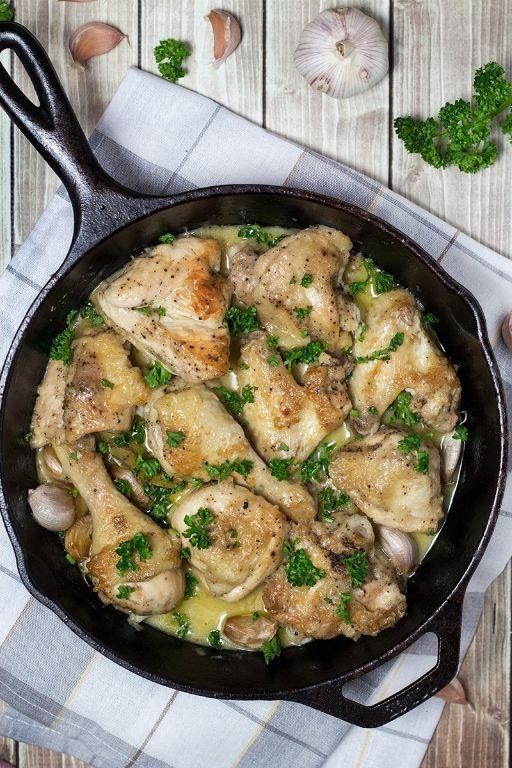
Perfecting this classic Spanish chicken dish requires precise technique and quality ingredients, but yields incredible flavor rewards. Pollo al Ajillo with White Wine combines tender poultry with aromatic garlic and bright acidity in a beautifully balanced preparation. Let’s walk through each step methodically to ensure your success in the kitchen.
Ingredients
– 1.5 pounds boneless, skinless chicken thighs, trimmed and patted dry
– 6 large garlic cloves, thinly sliced
– 1/2 cup dry white wine (such as Sauvignon Blanc)
– 1/4 cup extra virgin olive oil
– 1 tablespoon smoked paprika
– 1 teaspoon kosher salt
– 1/2 teaspoon freshly cracked black pepper
– 2 tablespoons fresh flat-leaf parsley, finely chopped
– 1/4 teaspoon red pepper flakes
Instructions
1. Pat the chicken thighs completely dry with paper towels to ensure proper browning.
2. Season both sides of the chicken evenly with kosher salt and freshly cracked black pepper.
3. Heat extra virgin olive oil in a large skillet over medium-high heat until shimmering but not smoking.
4. Carefully place chicken thighs in the hot oil, presentation side down, and cook undisturbed for 5-6 minutes until deeply golden brown.
5. Flip the chicken thighs using tongs and cook for another 4-5 minutes until the second side develops a rich crust.
6. Transfer the partially cooked chicken to a clean plate, leaving the rendered fat and oil in the skillet.
7. Reduce the heat to medium-low and add the thinly sliced garlic cloves to the skillet.
8. Sauté the garlic for 45-60 seconds until fragrant and lightly golden, stirring constantly to prevent burning.
9. Sprinkle smoked paprika and red pepper flakes over the garlic, stirring for 15 seconds to bloom the spices.
10. Pour the dry white wine into the skillet, using a wooden spoon to scrape up any browned bits from the bottom.
11. Simmer the wine mixture for 2-3 minutes until reduced by half and slightly thickened.
12. Return the chicken thighs and any accumulated juices to the skillet, nestling them into the sauce.
13. Cover the skillet and cook over low heat for 8-10 minutes until the chicken reaches an internal temperature of 165°F.
14. Remove from heat and stir in the finely chopped fresh parsley.
15. Let the dish rest for 3 minutes before serving to allow the flavors to meld.
Velvety chicken thighs contrast beautifully with the sharp, garlicky sauce that clings to each piece. The smoked paprika provides subtle smokiness while the white wine adds necessary acidity to cut through the richness. Serve this immediately over creamy polenta or with crusty bread to soak up every drop of the flavorful sauce.
Fabada Asturiana with Chorizo and Morcilla
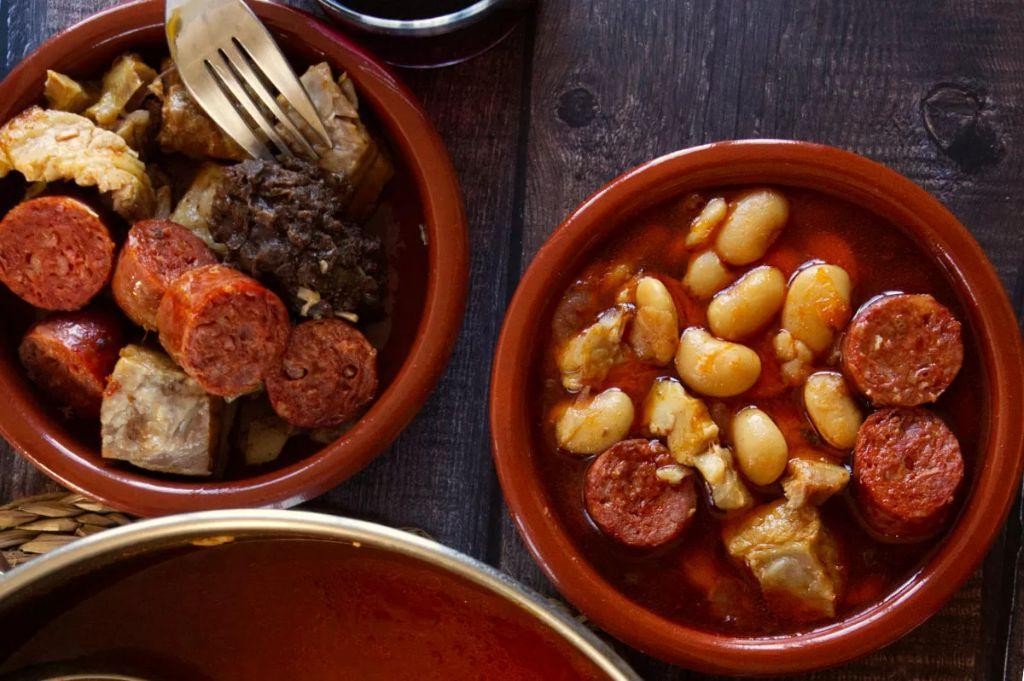
This traditional Spanish bean stew transforms humble ingredients into a deeply satisfying meal that warms both kitchen and soul. Through careful layering of flavors and patient simmering, you’ll create a rich, comforting dish perfect for chilly evenings.
Ingredients
- 1 pound dried large white beans, soaked overnight
- 8 ounces Spanish chorizo, sliced into ½-inch coins
- 8 ounces morcilla sausage, sliced into ½-inch coins
- 1 smoked pork hock
- 4 ounces slab bacon, cut into ½-inch lardons
- 1 large yellow onion, finely diced
- 4 garlic cloves, thinly sliced
- 2 bay leaves
- 1 teaspoon smoked paprika
- 8 cups rich chicken stock
- 2 tablespoons extra virgin olive oil
- 1 teaspoon fine sea salt
- ½ teaspoon freshly cracked black pepper
- 2 tablespoons fresh flat-leaf parsley, finely chopped
Instructions
- Heat 2 tablespoons extra virgin olive oil in a large Dutch oven over medium heat until shimmering.
- Add 4 ounces slab bacon lardons and render until golden brown and crisp, approximately 8-10 minutes.
- Transfer rendered bacon to a paper towel-lined plate using a slotted spoon, reserving fat in the pot.
- Sear 1 smoked pork hock in the rendered fat until deeply browned on all sides, about 6-8 minutes total.
- Add 1 large finely diced yellow onion to the pot and sauté until translucent and lightly caramelized, 6-8 minutes.
- Stir in 4 thinly sliced garlic cloves and cook until fragrant, approximately 1 minute.
- Sprinkle 1 teaspoon smoked paprika over the aromatics and toast for 30 seconds to release its oils.
- Drain 1 pound soaked white beans and add to the pot along with 8 ounces chorizo coins and 8 ounces morcilla coins.
- Pour in 8 cups rich chicken stock, ensuring ingredients are fully submerged.
- Add 2 bay leaves, 1 teaspoon fine sea salt, and ½ teaspoon freshly cracked black pepper.
- Bring the mixture to a gentle boil over high heat, then immediately reduce to the lowest possible simmer.
- Partially cover the pot and maintain a bare simmer for 2½ hours, checking occasionally that beans remain submerged.
- Remove the pork hock after 2½ hours and shred the meat from the bone using two forks.
- Return shredded pork and reserved crisp bacon to the stew.
- Continue simmering uncovered for 30 minutes to allow the broth to reduce and thicken naturally.
- Discard bay leaves and adjust seasoning with additional salt if needed.
- Stir in 2 tablespoons finely chopped fresh parsley just before serving.
Hearty and deeply satisfying, this stew develops a creamy texture from the broken-down beans that contrasts beautifully with the firm chorizo and tender morcilla. The rich, smoky broth carries layers of pork flavor that meld perfectly with the earthy beans. For an authentic presentation, serve in shallow bowls with crusty bread for dipping and a drizzle of high-quality olive oil to finish.
Rabo de Toro with Red Wine Sauce
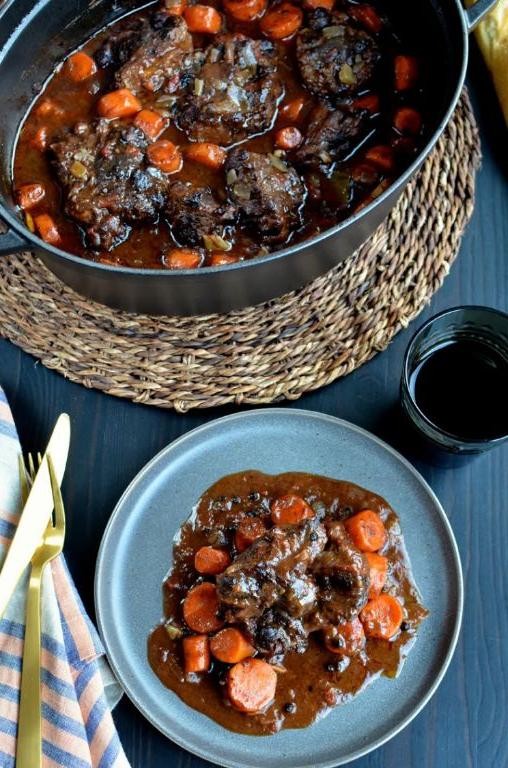
Let’s explore the rich, comforting world of Spanish oxtail stew, a dish that transforms humble ingredients into extraordinary depth through patient, methodical cooking. Learning this traditional preparation will give you confidence with slow-braised meats and complex wine reductions.
Ingredients
– 3 pounds oxtail segments, trimmed of excess fat
– 2 tablespoons extra virgin olive oil
– 1 large yellow onion, finely diced
– 2 medium carrots, peeled and cut into ¼-inch rounds
– 3 cloves garlic, minced
– 2 tablespoons tomato paste
– 2 cups full-bodied red wine (such as Tempranillo)
– 4 cups rich beef stock
– 2 bay leaves
– 1 teaspoon smoked paprika
– Kosher salt and freshly ground black pepper
– 2 tablespoons unsalted butter, chilled
– 2 tablespoons chopped fresh parsley
Instructions
1. Preheat your oven to 325°F and position a rack in the center.
2. Pat the oxtail segments completely dry with paper towels and season generously on all sides with kosher salt and freshly ground black pepper.
3. Heat the extra virgin olive oil in a large Dutch oven over medium-high heat until shimmering but not smoking.
4. Sear the oxtail segments in a single layer, working in batches if necessary, until deeply browned on all sides, approximately 4-5 minutes per surface.
5. Transfer the seared oxtail to a clean plate, leaving the rendered fat in the pot.
6. Reduce the heat to medium and add the finely diced yellow onion to the Dutch oven.
7. Sauté the onion until translucent and just beginning to caramelize at the edges, about 6-8 minutes.
8. Add the carrot rounds and minced garlic, cooking until fragrant, approximately 2 minutes.
9. Stir in the tomato paste and cook for 1 minute until it darkens slightly in color.
10. Pour in the red wine, using a wooden spoon to scrape any browned bits from the bottom of the pot.
11. Simmer the wine until reduced by half, about 8-10 minutes.
12. Return the oxtail segments to the Dutch oven along with any accumulated juices.
13. Add the beef stock, bay leaves, and smoked paprika, ensuring the oxtail is nearly submerged in liquid.
14. Bring the mixture to a gentle simmer, then cover tightly with the lid.
15. Transfer the covered Dutch oven to the preheated oven and braise for 3 hours until the meat is fork-tender and easily separates from the bone.
16. Carefully remove the Dutch oven from the oven and transfer the oxtail segments to a clean platter using tongs.
17. Strain the braising liquid through a fine-mesh sieve into a medium saucepan, pressing on the solids to extract maximum flavor.
18. Skim any visible fat from the surface of the liquid using a spoon.
19. Bring the strained liquid to a simmer over medium heat and reduce by one-third, about 15-20 minutes.
20. Whisk in the chilled unsalted butter one tablespoon at a time until the sauce becomes glossy and slightly thickened.
21. Return the oxtail to the sauce and warm through for 5 minutes over low heat.
22. Stir in the chopped fresh parsley just before serving.
Meticulously braised oxtail yields meat so tender it falls from the bone with gentle pressure, while the reduced red wine sauce provides a velvety, deeply savory coating. The collagen-rich broth creates a luxurious mouthfeel that clings beautifully to creamy polenta or rustic mashed potatoes. For an elegant presentation, garnish with additional fresh parsley and serve with crusty bread to capture every drop of the rich sauce.
Caldo Gallego with Greens and Ham

Meticulously crafted comfort in a bowl, this traditional Caldo Gallego transforms humble ingredients into a deeply satisfying meal. Let me guide you through creating this Spanish classic that balances smoky, savory, and earthy flavors in perfect harmony.
Ingredients
– 2 tablespoons extra virgin olive oil
– 1 large yellow onion, finely diced
– 3 cloves garlic, minced
– 8 ounces smoked ham hock
– 1 pound Yukon Gold potatoes, peeled and cubed
– 6 cups homemade chicken stock
– 1 bunch lacinato kale, stems removed and leaves chopped
– 1 bunch Swiss chard, stems removed and leaves chopped
– 1 (15-ounce) can cannellini beans, drained and rinsed
– 1 teaspoon smoked paprika
– ½ teaspoon freshly cracked black pepper
Instructions
1. Heat 2 tablespoons extra virgin olive oil in a large Dutch oven over medium heat until shimmering.
2. Add 1 large finely diced yellow onion and sauté for 5-7 minutes until translucent and fragrant.
3. Stir in 3 cloves minced garlic and cook for 60 seconds until aromatic but not browned.
4. Place 8 ounces smoked ham hock in the pot and sear for 3 minutes per side until lightly browned.
5. Add 1 pound cubed Yukon Gold potatoes and toss to coat in the aromatics.
6. Pour in 6 cups homemade chicken stock, scraping any browned bits from the bottom of the pot.
7. Bring to a gentle boil, then reduce heat to maintain a steady simmer for 25 minutes.
8. Stir in 1 bunch chopped lacinato kale and 1 bunch chopped Swiss chard, submerging completely.
9. Add 1 can drained cannellini beans, 1 teaspoon smoked paprika, and ½ teaspoon freshly cracked black pepper.
10. Simmer uncovered for 15 minutes until greens are tender but still vibrant.
11. Remove ham hock, shred the meat from the bone, and return meat to the soup.
12. Ladle into warm bowls and serve immediately. Velvety potatoes and tender greens create a satisfying texture contrast against the smoky ham broth. For an elegant presentation, garnish with a drizzle of high-quality olive oil and serve with crusty artisan bread for dipping into the rich, savory liquid.
Empanada Gallega with Tuna and Tomato
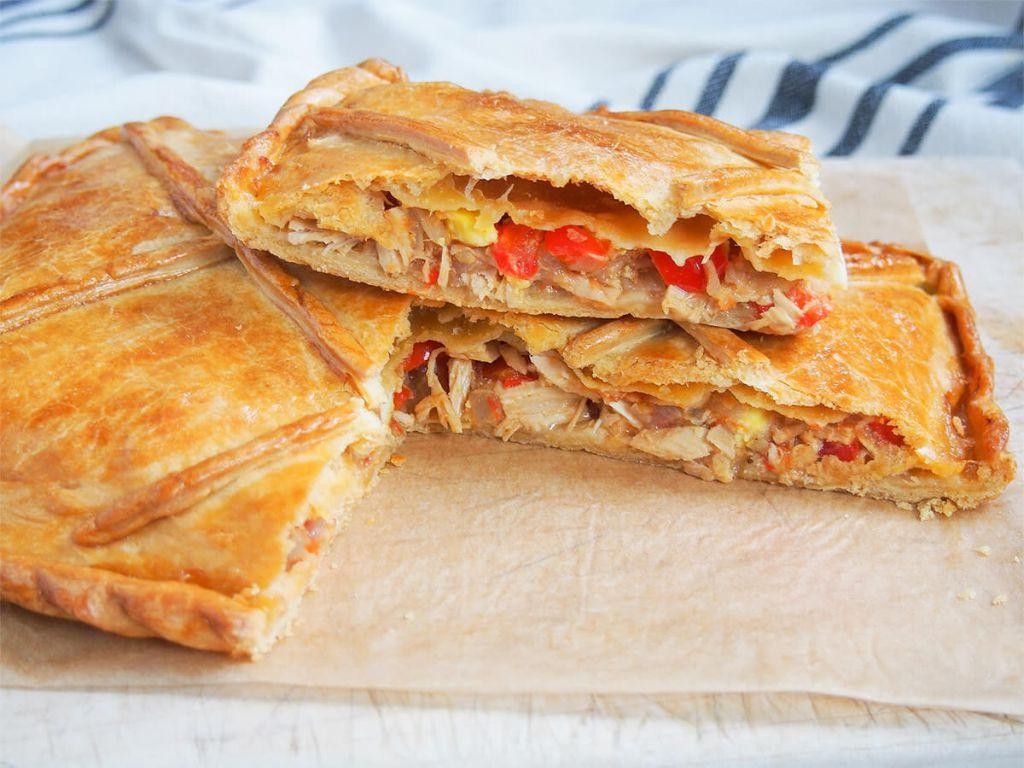
Developing the perfect empanada gallega requires patience and precision, but the reward is a stunning Spanish-style pie with flaky pastry and vibrant fillings. This tuna and tomato version brings Mediterranean flavors to your table through careful layering and baking techniques.
Ingredients
- 2 cups all-purpose flour, sifted
- 1/2 cup extra-virgin olive oil
- 1/4 cup dry white wine
- 1 teaspoon fine sea salt
- 1 large pasture-raised egg, lightly beaten
- 8 ounces high-quality canned tuna in olive oil, drained
- 1 large ripe heirloom tomato, thinly sliced
- 1 small sweet onion, julienned
- 2 cloves garlic, minced
- 1 teaspoon smoked paprika
- 1/4 teaspoon saffron threads, crushed
Instructions
- Combine sifted all-purpose flour and fine sea salt in a large mixing bowl.
- Create a well in the center and pour in extra-virgin olive oil and dry white wine.
- Mix with a wooden spoon until a shaggy dough forms, then knead on a floured surface for 8 minutes until smooth and elastic.
- Wrap the dough in plastic wrap and refrigerate for 30 minutes to relax the gluten.
- Heat 2 tablespoons of extra-virgin olive oil in a skillet over medium heat until shimmering.
- Sauté julienned sweet onion for 6-8 minutes until translucent and lightly caramelized.
- Add minced garlic and cook for 1 minute until fragrant but not browned.
- Stir in smoked paprika and crushed saffron threads to bloom the spices.
- Fold in drained high-quality canned tuna, breaking it into large flakes with a fork.
- Remove from heat and let the filling cool completely to prevent a soggy crust.
- Divide the chilled dough into two equal portions on a lightly floured surface.
- Roll one portion into a 10-inch circle about 1/8-inch thick for the base.
- Transfer the dough circle to a parchment-lined baking sheet.
- Spread the cooled tuna mixture evenly over the dough, leaving a 1-inch border.
- Arrange thinly sliced ripe heirloom tomato in a single layer over the tuna.
- Roll the second dough portion into a 10-inch circle for the top crust.
- Brush the border of the bottom crust with lightly beaten pasture-raised egg.
- Carefully place the top crust over the filling and press edges to seal.
- Crimp the edges with a fork and brush the entire surface with remaining beaten egg.
- Cut three small steam vents in the top crust with a sharp knife.
- Bake at 375°F for 25-30 minutes until golden brown and flaky.
- Let rest for 15 minutes before slicing to allow the filling to set.
Beautifully golden and structurally sound, this empanada delivers contrasting textures of flaky pastry against the moist, savory filling. The saffron-infused tuna melds wonderfully with the sweet acidity of heirloom tomatoes, creating a balanced flavor profile that improves after resting. Serve warm slices alongside a crisp green salad dressed with sherry vinaigrette for a complete Spanish-inspired meal.
Crema Catalana with Caramelized Sugar
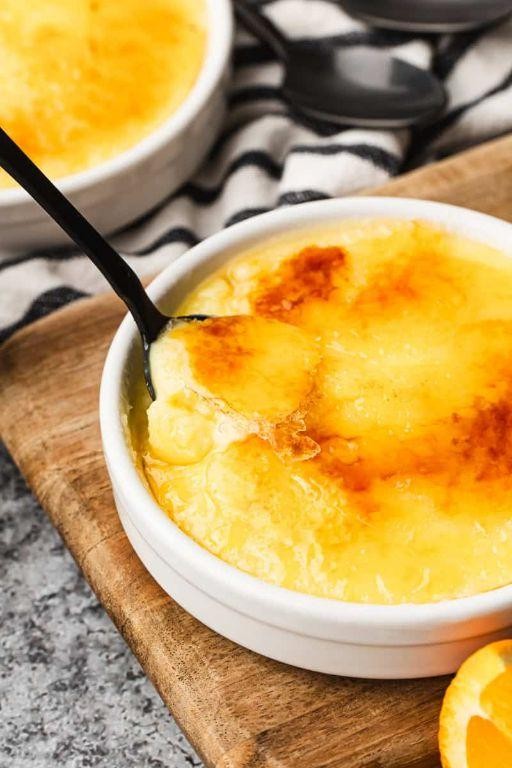
You’ve probably encountered crème brûlée, but its Spanish cousin Crema Catalana offers a distinctive citrus-kissed elegance that’s surprisingly approachable for home cooks. Let’s walk through creating this velvety custard crowned with that signature crackly caramelized sugar crust.
Ingredients
- 2 cups whole milk
- 1 cup granulated sugar, divided
- Zest of 1 large lemon
- 1 cinnamon stick
- 4 pasture-raised egg yolks
- 2 tablespoons cornstarch
- ¼ teaspoon fine sea salt
Instructions
- Combine 2 cups whole milk, ½ cup granulated sugar, lemon zest, and 1 cinnamon stick in a heavy-bottomed saucepan.
- Heat the mixture over medium heat until it reaches 180°F, stirring occasionally with a wooden spoon.
- Remove the saucepan from heat, cover, and let the infusion steep for 20 minutes to develop flavor depth.
- Whisk 4 pasture-raised egg yolks with remaining ½ cup granulated sugar in a medium bowl until pale and thickened, about 2 minutes.
- Sift 2 tablespoons cornstarch and ¼ teaspoon fine sea salt into the egg mixture, whisking until completely smooth.
- Strain the steeped milk through a fine-mesh sieve into the egg mixture, discarding the solids.
- Return the combined mixture to the saucepan and cook over medium-low heat, whisking constantly.
- Continue whisking for 6-8 minutes until the custard thickens noticeably and coats the back of a spoon.
- Immediately pour the custard through a fine-mesh sieve into a clean bowl to ensure silky texture.
- Divide the strained custard among 4-6 ramekins, tapping gently to remove air bubbles.
- Cover each ramekin directly with plastic wrap to prevent skin formation and refrigerate for at least 4 hours.
- Sprinkle a thin, even layer of remaining granulated sugar over each chilled custard just before serving.
- Caramelize the sugar using a kitchen torch held 3 inches above the surface, moving constantly until golden and bubbly.
- Allow the caramelized tops to harden for 1-2 minutes before serving.
Our finished Crema Catalana presents that perfect textural contrast between the brittle caramel ceiling and the luxuriously smooth, citrus-perfumed custard beneath. Orange blossom water makes a beautiful aromatic addition if you want to experiment with floral notes. Serve it immediately after torching to preserve that satisfying crack when your spoon breaks through the caramelized surface.
Churros con Chocolate Dipping Sauce
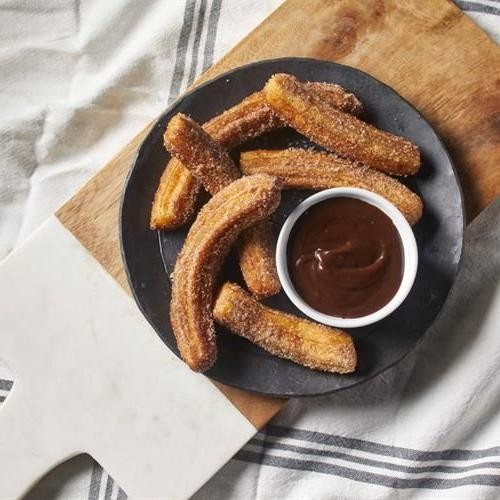
Frying up golden, cinnamon-sugar-dusted churros with rich chocolate dipping sauce transforms your kitchen into a Spanish café. Follow these precise steps to achieve that signature crisp exterior and tender interior that makes this treat irresistible. Let’s begin with the foundational dough that will create those perfect ridges when piped.
Ingredients
- 1 cup filtered water
- 4 tablespoons European-style unsalted butter
- 2 tablespoons granulated cane sugar
- 1/4 teaspoon fine sea salt
- 1 cup unbleached all-purpose flour
- 3 pasture-raised large eggs, lightly beaten
- 1/2 cup granulated cane sugar for coating
- 2 teaspoons Ceylon cinnamon
- 4 ounces 70% dark chocolate, finely chopped
- 1 cup heavy cream
- 1/2 teaspoon pure vanilla extract
- Vegetable oil for deep-frying
Instructions
- Combine 1 cup filtered water, 4 tablespoons European-style unsalted butter, 2 tablespoons granulated cane sugar, and 1/4 teaspoon fine sea salt in a heavy-bottomed saucepan.
- Heat the mixture over medium-high heat until it reaches a rolling boil at 212°F.
- Immediately remove the saucepan from heat and add 1 cup unbleached all-purpose flour all at once.
- Stir vigorously with a wooden spoon until the mixture forms a smooth ball that pulls away from the saucepan sides, about 1 minute.
- Transfer the dough to a stand mixer bowl and let it cool for 5 minutes until warm but not hot to the touch.
- With the mixer on medium speed, gradually add 3 lightly beaten pasture-raised large eggs in 4 separate additions, waiting until each portion is fully incorporated before adding the next.
- Continue mixing until the dough becomes glossy and holds a V-shape when the paddle is lifted.
- Fit a large piping bag with a closed star tip and fill it with the churro dough.
- Heat 3 inches of vegetable oil in a Dutch oven to 375°F, verified with a deep-fry thermometer.
- Pipe 4-inch lengths of dough directly into the hot oil, using kitchen shears to cut each churro cleanly.
- Fry 3-4 churros at a time for 2-3 minutes per side until golden brown and crisp, maintaining oil temperature between 370-380°F.
- Remove churros with a spider strainer and drain on a wire rack set over a baking sheet for 1 minute.
- Combine 1/2 cup granulated cane sugar and 2 teaspoons Ceylon cinnamon in a shallow bowl.
- Roll each warm churro in the cinnamon-sugar mixture until evenly coated on all surfaces.
- Heat 1 cup heavy cream in a small saucepan until it just begins to simmer around the edges at 180°F.
- Pour the hot cream over 4 ounces of finely chopped 70% dark chocolate in a heatproof bowl.
- Let the mixture stand undisturbed for 2 minutes to allow the chocolate to melt completely.
- Whisk the chocolate and cream together starting from the center and moving outward until emulsified and glossy.
- Stir in 1/2 teaspoon pure vanilla extract until fully incorporated.
Just-cooked churros should shatter audibly when broken, revealing a web-like interior that’s steam-tender. The bittersweet chocolate sauce provides a luxurious counterpoint to the cinnamon-sugar coating, creating a perfect balance of sweet and bitter notes. For an elegant presentation, serve the churros standing upright in tall glasses with the warm chocolate dipping sauce in individual ramekins alongside.
Conclusion
Savoring these 21 authentic Spanish recipes brings the vibrant flavors of Spain right to your kitchen! We hope this collection inspires you to cook, share, and enjoy. Try your favorites, leave a comment telling us which dish you loved most, and don’t forget to pin this article on Pinterest to save these delicious recipes for later. ¡Buen provecho!

